Drawing a Family Tree Symbols
Asking a patient about their family's medical history is a familiar scenario for most healthcare professionals. What might not be so familiar is the formal process of recording this information: the production of a family history diagram, also known as a genetic pedigree.
A genetic pedigree captures details about the health of multiple generations. This information can be important in diagnosing an inherited condition, revealing a pattern of inheritance, and informing clinical decisions regarding testing and management. Understanding the relationships between family members can also be useful when considering the communicaton of information and the clinical management of the whole family.
We believe all health professionals should be able to understand a genetic pedigree, and we have developed a range of educational resources to help you do this, as well as learn to take and draw a family history yourself, including a fully flexible online course.
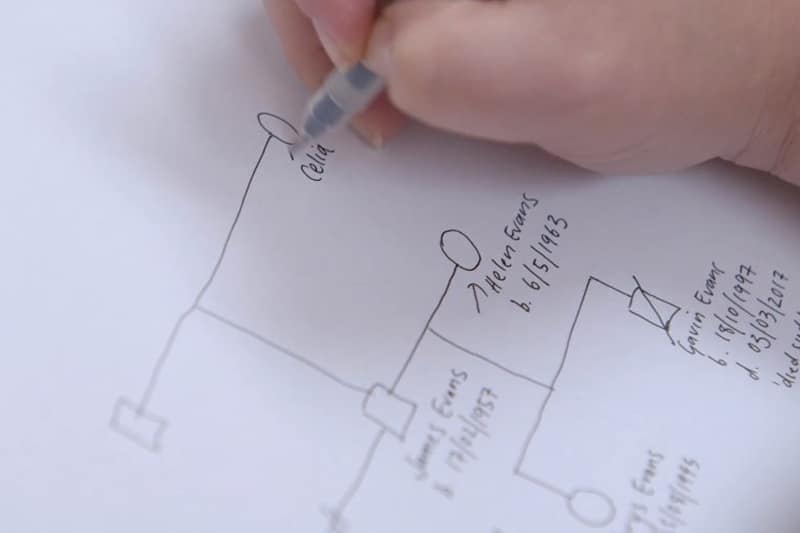
What is a genetic pedigree?
A genetic pedigree is a visual representation of several generations in a patient's family. It shows how family members are related to each other and notes any medical conditions they may have along with any other pertinent information. For example, a family's ethnic background may be relevant, as this could indicate whether certain tests should be considered based on the frequency of conditions in different populations.
The information needed to draw a pedigree is usually collected through a series of questions about each member of the family. Standardised symbols and lines are used to represent the family members and their relationships.
The example here shows a four-generation pedigree. The person giving the information is Julie Smith, as noted by the small arrow. Julie, her mother Mollie, her grandmother Alice, and her cousin Mary, have all been affected the same medical condition, indicated by the shaded circles.
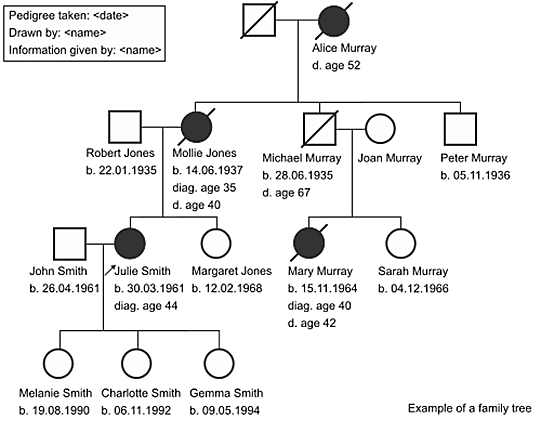
The symbols and lines
So that any health professional can read and understand a genetic pedigree, they use a set of internationally recognised symbols and lines, based on the proposed system by the National Society of Genetic Counselors.
Click on the image to zoom in or right-click to save and keep as a reference.
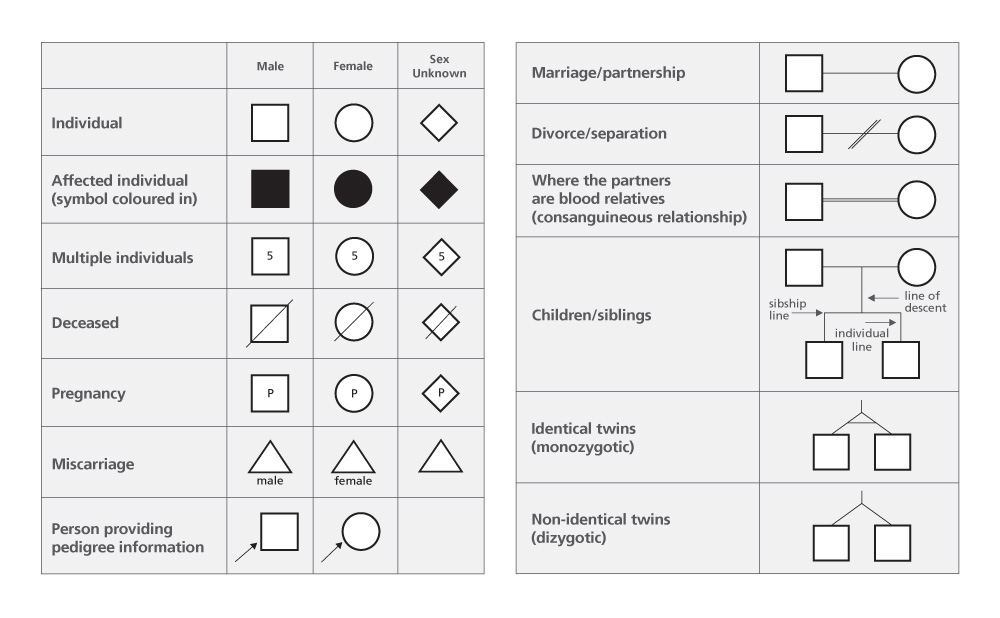
Frequently asked questions
Genetic counsellor Amanda Pichini answers some common family history queries.
How do I represent medical information on a pedigree?
For each person, record the following under the pedigree symbol:
- Name
- Date of birth (if known, the date of birth is preferable to current ages or estimates)
- Relevant symptoms and/or diagnoses and age at diagnosis (if known)
- Cause of death and age at death (if known)
Depending on the clinical question, you might also want to record:
- Pregnancy and birth history
- Occupational/environmental exposures
- Medications
Am I allowed to ask about other family members and record this information?
Yes, you may record information about other people in a family and pass it on to healthcare colleagues (under Schedule 3 of the Data Protection Act) without the consent of all those shown on the pedigree if this is necessary for medical purposes (including preventative medicine, medical diagnosis, medical research, the provision of care and treatment, and the management of healthcare services).
Can I show other family members a pedigree that I drafted with my patient?
If you have seen multiple members of the same family, it is important to consider that not all individuals will report the same family history, depending on what they know about the health and genetic testing history of their relatives. It is therefore important to avoid showing a patient a pedigree that you or someone else has taken from a relative, unless you know that explicit consent has been given to share this information.
In which order should I ask about people in the family?
It is best to ask for information about each person in turn, usually starting with your patient and moving through the family, generation by generation. The specific order may vary depending on who is affected with the condition, and its inheritance pattern. See the films below to see examples of how you could order the questions.
How do I know how many generations to include?
This depends on the reason for taking the family history. Typically, information about three generations of a family would be collected (for instance, your patient's generation, their parents' generation and grandparents' generation). In some clinical situations, you may be required to ask for broader details about the family and their medical conditions. In others, you may need information about a specific condition.
What do I do if I need to make changes to the genetic pedigree at a later date?
It is important to clearly document who took a genetic pedigree and the date. If there are updates to a family history such that the pedigree can be amended at a later date, add your name and the date of the update, as well as use a different coloured pen to note any changes, or upload the pedigree as a separate document in an electronic record system. Visualising genetic pedigrees taken at different times is important for the patient and their healthcare professionals to understand why certain investigations were pursued or not, based on what was understood about that family or condition at each point in time.
Useful resources
Family pedigree films
If you would like to learn how to take and draw a family history yourself, these films may be helpful. They take three patient scenarios viewed from two perspectives: the conversation, focusing on the types and order of questions asked; and the pedigree, focusing on the symbols and lines being used.
You can use the films to both learn and practise: watch the pedigree films to see how a pedigree is created, and then watch the conversation films and try drawing the family history yourself, using our worksheet below. You can then compare with the drawn pedigree at the end.
Family history worksheet
You can use this worksheet to practise drawing a family history. It shows the main symbols and lines used, with space alongside to draw a pedigree. Click on the image to view, print or save.
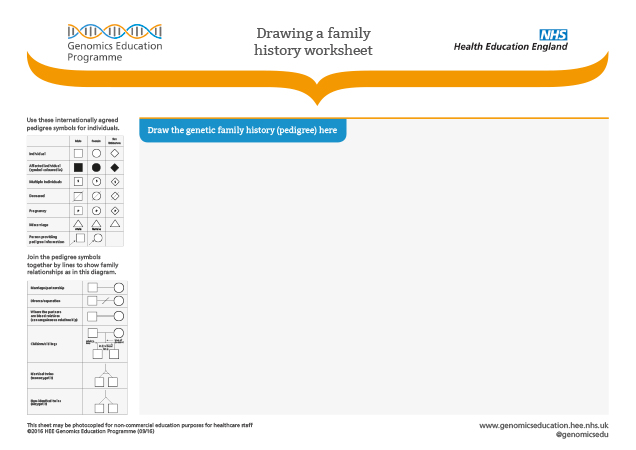
Family history template tool
This handy tool acts as both a template for creating a patient's genetic family history, and a reminder of the key symbols, lines and information to include. Made from sturdy 1mm plastic, it can be a permanent part of your clinical toolkit. NHS staff and educators can request a free copy of the tool.
Note: Due to remote working within HEE, the physical tools can only be accessed and sent on a monthly basis. We will endeavour to get them to you as soon as we can, but appreciate your understanding in the event of delay.
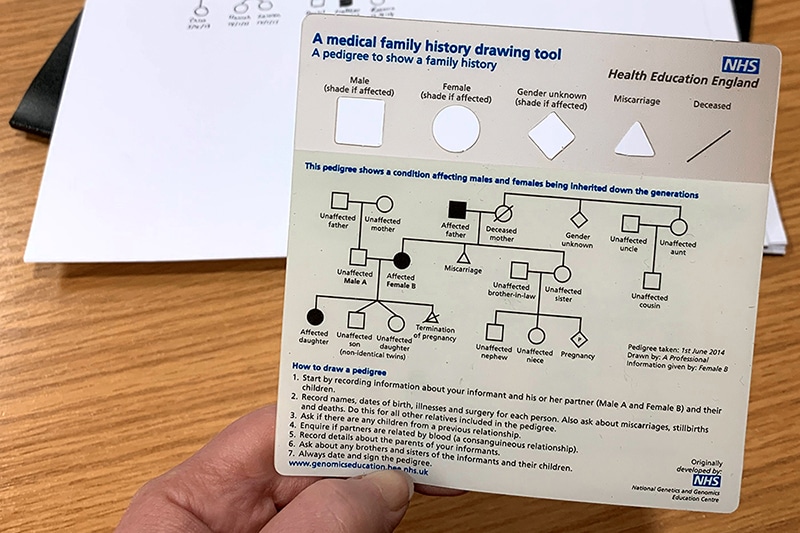
Learn more
Build up your knowledge of taking and drawing a family history, and how genomic information can be passed down through a family, with these free courses and resources.
Source: https://www.genomicseducation.hee.nhs.uk/taking-and-drawing-a-family-history/
0 Response to "Drawing a Family Tree Symbols"
Post a Comment